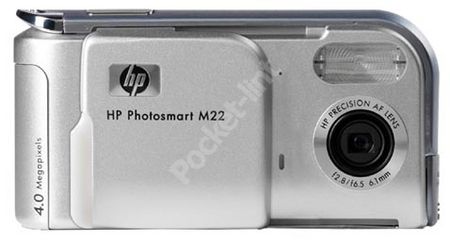The M22 is a sweet little digital camera pitched at the entry-level end of the market but with a fair specification and with good build quality. An all-metal weatherproofed body is the standout feature while in terms of build; particularly at this price/level, it meets the "IEC specification 60529, Grade 4", a standard for such weatherproofery. In other words, it can withstand "water spray" from any direction.
Our quick take
A weatherproof, all-metal digital compact for a penny less than £90 is pretty much a bargain by pretty much any standards, here the bonus of weatherproofing makes it particularly ideal for those out and about types among you. And while the M22's larger print capability may be compromised by the camera's harsh processing, if all you need are snaps while walking or when out and about, then this little camera might be just the one you've been waiting for.

HP PhotoSmart M22 digital camera - 3.5 / 5
| FOR | AGAINST |
|---|---|
|
|
Such small cameras can sometimes create handling problems but not so here, the simple controls and their layout on the camera body means it's controllable without you getting all fingers and thumbs, particularly important as the last thing you want is an errant finger straying in front of the lens when snapping, a real risk with small cameras.
Talking of the lens, some might be put off by the lack of a zoom optic, but a fixed focal length lens can often provide better detail than a Jack of all trades zoom; unfortunately it's hard to tell here (and which I'll talk more on in a moment). This lens is the 35mm film equivalent of a 36.7mm optic. It lacks any form of filter thread, which is a shame as in my shots, lens flare (which can adversely affect image contrast) could be improved with a screw-in lens hood for example. In addition, barrel distortion was very noticeable.
Other specification includes a range of auto shooting options, with typical scene modes that include the usual gamut of Portrait, Landscape, Sports, Beach, Snow and the like. Auto ISO with 100, 200 and 400 settings are basic while the addition of exposure compensation in not, making this camera a tad more controllable in difficult lighting.
The camera is not the fastest to use, lacking any real continuous shooting mode, AF is sluggish (like most cameras at this level) and the flash recycle can take up to 6 seconds between shots. Battery usage is a bit of a worry, with standard alkaline AAs (of which it needs two) throwing in the towel after around ten snaps. Rechargeable AAs are a must, so budget for a set if you buy this camera, then you can get a more respectable 100 or so shots between charges.
However, HP's adaptive lighting technology and in camera redeye removal are also built into this little camera, which is used to boost shadows without affecting highlights, making high contrast or backlit subjects look more natural. When combined with the flash it can help reduce the effects of flash fall off as well, so is very neat. It does however introduce a tad more noise into the images.
The small colour screen seems small by today's standards, but what screen there is reasonably sharp although bright direct light is a problem as is the lack of an optical viewfinder in such conditions.
Neat menus and simple controls are complemented by great Help screens for each setting and help menus to back things up at a deeper level, making the camera very easy to learn as you go.
A modest 320x240-pixel video mode is included as is 2320x1744-pixel (4-megapixel) top still resolution with Best and Standard compression settings; 12-bit per colour depth provides vibrant and rich looking shots all of which get stored on the removable SD/MMC cards or the 16MB of internal storage.
One of the more worrisome things regarding the image quality is the way, what can only be in camera processing actually smoothes detail out of a shot, fine detail becomes an impressionist style mish mash of colourful blobs.
The bottom line is simply that any prints you make from this camera's images at normal enprint size (6x4-inches) it would not be apparent. However, as soon as you crop in or make larger prints (which can be up to or over A3 with a 4-megapixel camera with little work on PC) this "smoothing" could become apparent.
Metering and the AF system work well (although there's only a modest 20cm Macro setting) work efficiently enough, plus you have the back up of both exposure compensation and Adaptive Lighting to fall back on in difficult lighting situations.
To recap
The HP PhotoSmart M22 is neat little package at the entry point for novice snappers
